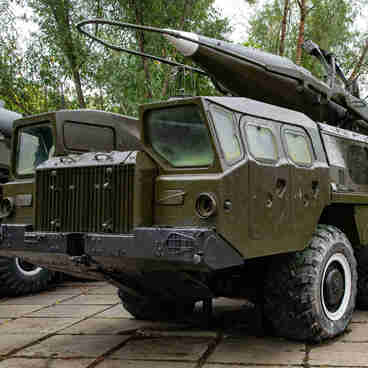The 122mm howitzer M1938 was developed in the design bureau of the Motovilikha Plants. The project was led by Fyodor Fyodorovich Petrov, the weapon entered service in 1939.
This howitzer was designed to destroy and suppress manpower, enemy infantry and artillery firepower, and terminate field-type defensive structures. The M-30 howitzer had a split trail wheeled carriage with leaf spring suspension. The design allowed to fire with wide elevation and horizontal firing angles, and also had high mobility when towed.
The howitzer was fitted with new technical systems: the recoil was taken up by a cylinder mounted parallel to the barrel, thus, the recoil was softened. When on the move, the barrel was not disconnected from the recoil system, but was fixed without pulling it into the rear.
The barrel of the howitzer consisted of a tube, jacket and screw breechblock. The interrupted-screw breechblock had a nonconcentrically positioned opening for the exit of the striker. The bolt could be opened and closed with the handle in one move. The striker was cocked and released by a trigger cord. In case of a misfire, the firing sequence could be repeated.
After the shot, the spent cartridge case was removed by the ejector mechanism when the bolt was opened. This design allowed the rate of fire of the weapon to be up to six rounds per minute. By 1955, about 20 thousand units of M-30 howitzers had been manufactured.
Most of these guns were produced at the Sverdlovsk Artillery Factory No. 9. The 122mm M-30 howitzers became the largest-caliber guns of the Soviet Division Artillery during the Great Patriotic War.
The former Artillery Commander of the Leningrad Front, Marshal of the Artillery Georgy Fedotovich Odintsov highly valued the new weapon. He said about the howitzer: “Nothing else could ever surpass it.”
It was used in almost all significant wars and armed conflicts since the 1940s. This howitzer almost in its original modification is still widely used by the CIS and other countries, but in many armies, it is used only for training purposes.
This howitzer was designed to destroy and suppress manpower, enemy infantry and artillery firepower, and terminate field-type defensive structures. The M-30 howitzer had a split trail wheeled carriage with leaf spring suspension. The design allowed to fire with wide elevation and horizontal firing angles, and also had high mobility when towed.
The howitzer was fitted with new technical systems: the recoil was taken up by a cylinder mounted parallel to the barrel, thus, the recoil was softened. When on the move, the barrel was not disconnected from the recoil system, but was fixed without pulling it into the rear.
The barrel of the howitzer consisted of a tube, jacket and screw breechblock. The interrupted-screw breechblock had a nonconcentrically positioned opening for the exit of the striker. The bolt could be opened and closed with the handle in one move. The striker was cocked and released by a trigger cord. In case of a misfire, the firing sequence could be repeated.
After the shot, the spent cartridge case was removed by the ejector mechanism when the bolt was opened. This design allowed the rate of fire of the weapon to be up to six rounds per minute. By 1955, about 20 thousand units of M-30 howitzers had been manufactured.
Most of these guns were produced at the Sverdlovsk Artillery Factory No. 9. The 122mm M-30 howitzers became the largest-caliber guns of the Soviet Division Artillery during the Great Patriotic War.
The former Artillery Commander of the Leningrad Front, Marshal of the Artillery Georgy Fedotovich Odintsov highly valued the new weapon. He said about the howitzer: “Nothing else could ever surpass it.”
It was used in almost all significant wars and armed conflicts since the 1940s. This howitzer almost in its original modification is still widely used by the CIS and other countries, but in many armies, it is used only for training purposes.




